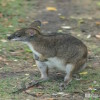Macropus parma
The head and body length of the Parma Wallaby ranges from 17 to 21 inches, tail length from 16 to 21 inches, and weight from 7 to 13 pounds. Males are larger than females, and have a more robust chest and arms. The Parma Wallaby is normally solitary under natural conditions, although feeding aggregations of 2, and rarely 3 are sometimes observed. Primarily nocturnal, they take cover among the shrubs during the day and emerge at dusk, or shortly before, to feed on grasses and herbs. When hopping, they remain close to the ground in an almost horizontal position with the forearms tucked tightly against the body. At a medium pace the tail is curved upward in a shallow U-shape. It was thought to have become extinct during the nineteenth century, when foresters were doing their best to eliminate it because of damage to pine plantations. Some were exported to zoos and research institutions to establish breeding colonies from which the species might be returned to the wet forests of New South Wales. However, surveys demonstrated that it still occurred in New South Wales.

